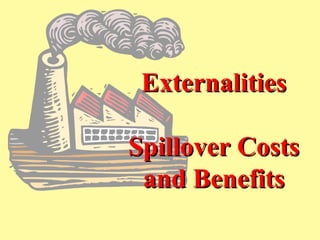
Market failure
- 1. Externalities Spillover Costs and Benefits
- 2. Market Failures —Caused by either externalities (spillover) or information problems √ Externalities failures: (cost or benefit accruing to an individual or group—a third party—which is external to the market transaction) • Failure of the market to bring about the allocation of resources that best satisfies the wants of society. • Results in either overallocation or underallocation of resources dedicated to the production of a particular good or service.
- 3. When there are NO externalities involved: • No benefits or costs beyond those to consumer • Qe is efficient allocation equilibrium, so MB=MC.
- 4. OPTIMAL AMOUNT OF A PUBLIC GOOD P $9 S=MSC 7 The public good’s 5 marginal Cost as shown by the 3 Supply Curve 1 D=MSB 0 1 2 3 4 5 Q
- 5. OPTIMAL AMOUNT OF A PUBLIC GOOD P $9 S=MSC 7 Yields the optimum amount 5 of the public good 3 MB = MC 1 D=MSB 0 1 2 3 4 5 Q
- 6. Cost-benefit Analysis Marginal Cost = Marginal Benefit Rule Externalities Spillover Costs Overallocation Spillover Benefits Underallocation
- 7. Spillover Costs And Benefits P Spillover S=MSC costs S=MPC D=MB Overallocation Q0 Qe Q 0
- 8. Overallocation of resources √ when external costs are present and suppliers are shifting some of their costs onto the community, making their marginal costs lower. √ The supply does not capture all the costs with the MPC curve understating total production costs. √ This means resources are overallocated to the production of this product. √ By shifting costs to the consumer, the firm enjoys MSC curve and Qo (optimum output ).
- 9. Spillover Costs And Benefits P Spillover S=MSC costs S=MPC D=MB Overallocation Q0 Qe Q 0
- 10. Spillover Costs And Benefits P S=MC Spillover Benefits D=MSB D=MPB Underallocation Qe Q0 Q 0
- 11. Underallocation of resources √ when external benefits are present and the MPB curve reflects only the private benefits understating the total benefits, at Qe. √ The output at Qo is optimum and reflects the MSB curve and the S curve. √ External positive benefits will accrue to society from the consumption of this product.
- 12. Spillover Costs And Benefits P S=MC Spillover Benefits D=MSB D=MPB Underallocation Qe Q0 Q 0
- 13. Correcting Spillover Costs Individual Bargaining Coase Theorem Liability Rules and Lawsuits Government Intervention Direct Controls Specific Taxes Subsidies and Government Provision
- 14. Correcting Spillover Costs S=MSC P Spillover costs S=MPC TAX Overallocation D=MB Corrected Q0 Qe Q 0
- 15. Correcting for Spillover Benefits Subsidy to: • Buyer to “lower” the price; more units will be sold. • Seller to “lower” the marginal cost of producing. More units will be produced and sold.
- 16. Correcting for Spillover Benefits P Correcting by Subsidy to Consumers S=MC Subsidy to consumer increases demand D=MSB Underallocation D=MPB Corrected Qe Q Q 0 0
- 17. Correcting for Spillover Benefits P Correcting by Subsidy to Producers S=MPC S=MSC Subsidy to producers increases supply D=MB Underallocation Corrected Qe Q0 Q 0
- 18. Problem Resource Ways to Correct allocation Spillover Overallocation •Individual Costs of Resources Bargaining Negative •Liability rules and External lawsuits -ities •Tax on Producers •Direct Controls •Market for Externality rights
- 19. Problem Resource Ways to Allocation Correct Spillover Underallocation •Individual Benefits of Resources Bargaining Positive •Subsidy to Externalities consumer •Subsidy to producer •Government Provision
- 20. Market for Externality Rights: D 2002 S = Supply √ Determine Price per pollution right of “rights” (supply is $200 pollution fixed) rights √ Demand is $100 D 2012 downsloping; 500 750 1000 demand will increase over time Quantity of pollution rights as human and Equilibrium price for business “rights” will be intersection populations of demand and supply. increase.
- 21. Market for Externality Rights: D 2002 S = Supply Price per pollution right Firms are either of encouraged to $200 pollution reduce or rights eliminate it based $100 D 2012 on their costs and 500 750 1000 the price of the Quantity of pollution rightsright to pollute. Pollution Rights can be bought and sold; conservation groups can “buy” up rights to control spillover costs.
- 22. Society’s Optimal Amount Of Externality Reduction MC Society’s marginal benefit and marginal Socially optimum cost of pollution abatement amount of pollution abatement MB 0 QO Amount of pollution abatement